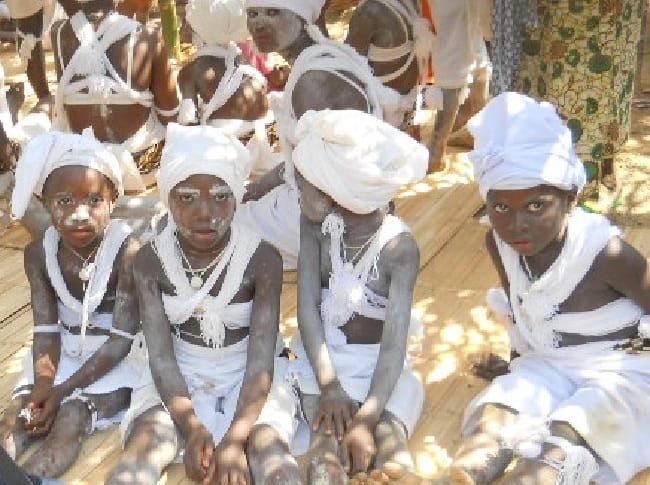When one thinks of secret societies, what usually comes to mind are groups like the age-old Illuminati or the Freemasons. However, in the thick forests of Liberia, Sierra Leone, Guinea and Côte d’Ivoire, lie two powerful institutions who quietly continue to shape local culture. For generations, the Poro (for men) and the Sande (for women) have governed the initiation of children into adulthood and preserved unique moral and spiritual codes.
While they operate separately, their purposes mirror each other in more ways than one. Together, they maintain the social harmony and identity of the ethnic groups that uphold them—most notably the Mende, Vai, Gola, and Temne.
The Origins of Poro and Sande
The earliest documented account of the Sande society came in 1668, 40 years after a Dutch geographer named Olfert Dapper had discovered them in the Cape Mount region of Liberia. Anthropologists believe that they originated in Gola society, in present-day Liberia and Sierra Leone, before spreading to the neighbouring Mende and Vai ethnic groups. Today, Sande can be found among several other ethnic groups across Liberia, Sierra Leone and Guinea. In some of these communities, they are called Bondo instead.
The Poro, on the other hand, seem to date even further back. Some say it was introduced by Mane people, a warrior group who migrated to the same region from Sudan circa 1000 AD. What is clear is that both societies have long histories, preserved through oral tradition and ritual. Their customs are fiercely protected by secrecy.
Till today, among the Mende people of Sierra Leone, a man cannot hold authority if he is not a part of the Poro society. Both Poro and Sande enforce community laws, regulate sexual and social behaviour, and play a role in spiritual matters like fertility rites and ancestral honouring. In northern Côte d’Ivoire, all adult men of the Senufo ethnic group belong to the Poro society.
Becoming Sande and Poro
Initiation is perhaps the most well-known feature of both societies. For boys entering the Poro and girls entering the Sande, the journey starts with withdrawal from everyday life and seclusion in the bush.
For Sande initiates, the rite typically happens after harvest season and lasts around 3–4 weeks, although it used to span months, sometimes a year. Initiation is so central that girls cannot marry without it. Upon completing the rite, they’re given new names that replace their birth names.
What happens in the bush is largely secret. This is because the initiates take an oath of secrecy, for which they are told the price of defiance is death to them or their family members. However, it is known that a highly respected Sande leader performs Female Genital Mutilation (FGM) as part of the process. The ‘skilled’ leader cuts off a part of the initiate’s labia and clitoris, without offering any anaesthesia. This is believed to curb sexual desire and promiscuity in women so that they can become marriageable.
However, the practice has been widely condemned by human rights groups. FGM is linked to several complications that damage women’s health and the premise behind it is also considered a violation of women’s bodily autonomy. Some community members, particularly younger generations and returning diasporans, are calling for reforms. In some areas, alternative rites of passage that preserve the cultural richness of initiation without physical harm have started to gain traction under the direction of more progressive Sande leaders.
After the initiation process, the girls are enrolled in a bush school where they are trained in domestic tasks, herbal medicine, child-rearing, farming, and etiquette. They’re also taught moral codes and social navigation, often through song and dance. The schooling is an essential part of the new women’s cultural integration. The new women also undergo various forms of scarification and body modifications.
Membership in the Sande society is a lifelong identity that members pass down to their daughters. The women stand in solidarity, so much that if a man treats a Sande woman badly, he is ostracised by all Sande women. In this way, women have the power to hold men accountable.
Poro initiation for boys follows a similar format but focuses more on physical resilience, leadership, and warfare. Boys are taught to hunt, farm, heal, and lead. Circumcision, if not already done, takes place during initiation. Like the Sande, Poro also uses stories, songs, and symbols to pass on its values. In the Senufo tradition, wooden figures are used during rites to invoke ancestral spirits.
After initiation, men continue to meet in the bush regularly—usually in the dry season. These meetings are secret, guarded, and off-limits to outsiders. Ceremonies are led by the ‘Poro devil’, a man in a ‘fetish dress’ who speaks through a long wooden tube. Masks are central among the Poro too, often representing spirits. The most revered is the ‘Old Mother’, a female spirit said to protect initiates.
Poro members have their own symbolic scripts, taboos, and rituals. Taboos can be imposed on individuals, places, or even crops. Defying a Poro taboo has real-world consequences. In 1897, colonial authorities had to step in when Poro leaders began placing taboo on entire food supplies.
The Sande and Poro Leaders
In the Sande, the elder women are called zoes. They are healers, educators, spiritual guides, and cultural custodians. The zoes also collect a substantial initiation fee from the initiate’s father or prospective husband.
One of the most recognisable features of the Sande Society is the use of the Sowei mask—an artistic and spiritual object worn by zoes during dances and rituals. In some ethnic groups where the Sande society is present, the spirit represented by the mask is said to be male rather than female. Nonetheless, these wooden face masks are among the few African masks created and worn exclusively by women, symbolising power and beauty The masks are often worn alongside a unique raffia palm costume.
In the Poro society, the highest-ranking member is called the Taso (in Mende) or Kashi (in Temne). He wears an intricate headdress made from wood and cane. More interestingly, the headdresses typically exhibit human skulls and thighbones which are said to belong to former Tasos. To become a Taso, one must pay a fee and be rigorously trained in the use of special medicines by an existing Taso. Poro elders perform similar roles to the zoes. They are the decision-makers in village councils and often serve as intermediaries between the physical and spiritual realms. Their authority is respected even by state officials and religious leaders.
Gender, Power, and Balance
What’s particularly striking about the existence of these two societies is how they maintain a gendered balance of power. While men dominate public-facing leadership roles, the Sande society gives women real political and social leverage within the community. In some regions, the Sande has more influence than the Poro, especially when it comes to decision-making around community rituals, marriages, and land disputes.
The societies work in tandem. They schedule their bush-based initiations so that they do not overlap. They also alternate political and ritual control of the land for periods of 3-4 years. This careful choreography ensures that both groups are respected and have space to exercise their influence.
The Enduring Relevance of the Poro and Sande Societies
Over the years, both societies have adapted—sometimes under pressure, sometimes by choice. Liberia’s former President W.V.S. Tubman (1944-71) formally brought the Poro under the Ministry of Local Government, giving it legal backing. Today, their rituals and rules still shape social life in many rural communities.
These societies are not perfect. They have their flaws, their critics, and their complications. But they are rooted. Resilient. Fiercely defended by the people who call them home.
And in a world obsessed with surveillance, sharing, and digital footprints, perhaps the true power of Poro and Sande lies in the one thing they refuse to give away: their secrets.

Oyindamola Depo Oyedokun
Oyindamola Depo Oyedokun is an avid reader and lover of knowledge, of most kinds. When she's not reading random stuff on the internet, you'll find her putting pen to paper, or finger to keyboard.
follow me :
Leave a Comment
Sign in or become a Africa Rebirth. Unearthing Africa’s Past. Empowering Its Future member to join the conversation.
Just enter your email below to get a log in link.


Related News
Decoding Nsibidi: The Visual Writing System of the Ekpe Secret Society
Aug 09, 2025
Matrilineal and Matriarchal Societies in Africa Today
Aug 09, 2025
How Ancient Mombasa Became the Gateway of African Commerce
May 31, 2025